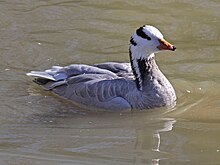Bar-headed Goose
| Bar-headed Goose | |
|---|---|
 | |
| Conservation status | |
| Scientific classification | |
| Kingdom: | Animalia |
| Phylum: | Chordata |
| Class: | Aves |
| Order: | Anseriformes |
| Family: | Anatidae |
| Subfamily: | Anserinae |
| Tribe: | Anserini |
| Genus: | Anser |
| Species: | A. indicus |
| Binomial name | |
| Anser indicus (Latham, 1790) | |
| Synonyms | |
Eulabeia indica
| |
The Bar-headed Goose (Anser indicus) is a goose which breeds in Central Asia in colonies of thousands near mountain lakes and winters in South Asia, as far south as peninsular India. It lays three to eight eggs at a time in a ground nest.
Life and habitat
The summer habitat is high altitude lakes where the bird grazes on short grass. The species has been reported as migrating south from Tibet, Kazakhstan, Mongolia and Russia before crossing the Himalaya. The bird has come to the attention of medical science in recent years as having been an early victim of the H5N1 virus, HPAI (highly pathogenic avian influenza), at Qinghai. It suffers predation from crows, foxes, ravens, sea eagles, gulls and others. The total population may, however, be increasing, but it is complex to assess population trends as this species occurs over more than 2.5 million square kilometres.
The Bar-headed Goose is thought to be one of the world's highest flying birds, having been heard flying across Mount Makalu (the fifth highest mountain on earth at 8,481 metres (27,825 ft)) and apparently seen over Mount Everest (8,848 metres (29,029 ft), although this is a second hand report with no verification).This incredibly demanding migration has long puzzled physiologists and naturalists: "there must be a good explanation for why the birds fly to the extreme altitudes […] particularly since there are passes through the Himalaya at lower altitudes, and which are used by other migrating bird species" quoted from Black & Tenney (1980). In fact bar-headed geese have never been directly tracked (using GPS or satellite logging technology) flying higher than 6,540 metres (21,460 ft), and it is now believed that they do take the high passes through the mountains. The challenging northward migration from lowland India to breed in the summer on the Tibetan Plateau is undertaken in stages, with the flight across the Himalaya (from sea-level) being undertaken non-stop in as little as seven hours. Surprisingly, despite predictable tail winds that blow up the Himalayas (in the same direction of travel as the geese), bar-headed geese spurn these winds, waiting for them to die down overnight, when they then undertake the greatest rates of climbing flight ever recorded for a bird, and sustain these climbs rates for hours on end.
The bar-headed goose is known to be well equipped for this incredibly challenging migration. It has a slightly larger wing area for its weight than other geese, which is believed to help the goose fly at high altitudes. Studies have found that they breathe more deeply and efficiently under low oxygen conditions The haemoglobin of their blood has a higher oxygen affinity than that of other geese.
The Bar-headed Goose migrates over the Himalayas to spend the winter in parts of India (from Assam to as far south as Tamil Nadu. The winter habitat of the Bar-headed Goose is cultivated fields, where it feeds on barley, rice and wheat, and may damage crops. Birds from Kyrgyzstan have been noted to stopover in western Tibet and southern Tajikistan for 20 to 30 days before migrating further south. Some birds may show high wintering site fidelity.

The bird is pale grey and is easily distinguished from any of the other grey geese of the genus Anser by the black bars on its head. It is also much paler than the other geese in this genus. In flight, its call is a typical goose honking. The adult is 71–76 centimetres (28–30 in) and weighs 1.87–3.2 kilograms (4.1–7.1 lb).

The bird is pale grey and is easily distinguished from any of the other grey geese of the genus Anser by the black bars on its head. It is also much paler than the other geese in this genus. In flight, its call is a typical goose honking. The adult is 71–76 centimetres (28–30 in) and weighs 1.87–3.2 kilograms (4.1–7.1 lb).
It has sometimes been separated from Anser, which has no other member indigenous to the Indian region, nor any at all to the Ethiopian, Australian, or Neotropical regions, and placed in the monotypic genus Eulabeia.
They nest mainly on the Tibetan plateau. Intraspecific brood parasitism is noticed with lower rank females attempting to lay their eggs in the nests of higher ranking females.
The Bar-headed Goose is often kept in captivity, as it is considered beautiful and breeds readily. Records in Great Britain are frequent, and almost certainly relate to escapes. However, the species has bred on several occasions in recent years and around five pairs were recorded in 2002, the most recent available report of the Rare Birds Breeding Panel. It is possible the species is becoming gradually more established in Great Britain. The bird is sociable and causes no problems for other birds.The "wild" population is believed to be declining in Great Britain due to over-hunting.













No comments:
Post a Comment